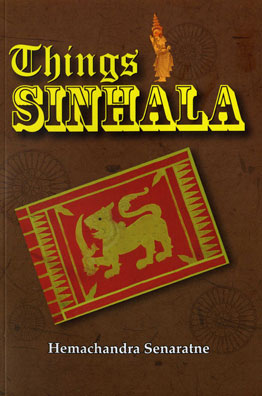Cultural identity of the Sinhalese
Things Sinhala
Author: Hemachandra Senaratne
An author publication
Hemachandra Senaratne, journalist, author and teacher has launched
his book Things Sinhala, after a careful and detailed compilation of
age-old cultural intricacies of the Sinhala people. The identity of a
group of people always rests on the beliefs and customs of its people.
Hence the collection of practices, beliefs and rituals common to a group
of people comprises their cultural identity.
 Many races lose the traditional practices and valued with time due to
interchange of ideas with different cultures and modernisation. The
Sinhala culture is no exception. The age-old beliefs have been replaced
by modern scientific explanations. The time consuming but pleasant
practices of the early Sinhala people have been replaced by practices to
suit the busy urban lifestyles of the modern society. Through his book
Senaratne has documented disappearing beliefs and practices. Many races lose the traditional practices and valued with time due to
interchange of ideas with different cultures and modernisation. The
Sinhala culture is no exception. The age-old beliefs have been replaced
by modern scientific explanations. The time consuming but pleasant
practices of the early Sinhala people have been replaced by practices to
suit the busy urban lifestyles of the modern society. Through his book
Senaratne has documented disappearing beliefs and practices.
He recognises and highlights the intrusions from the outside cultures
but also commends the efforts taken by the people to preserve the
remaining values and practices in spite of many foreign invasions.
The book takes the reader on a journey exposing him to the cultural
practices of the Sinhala people from birth to death emphasising the
important events. Many beliefs and practices associated with the
day-to-day activities of the people such as marriage, child birth,
puberty, cultivating paddy, and buying and selling are also highlighted.
Moreover, the book documents in detail the vanishing practices such
as bathgediya when visiting relatives and friends and marriages between
cousins. An elaborate account of the elephants, is also included in the
book. Interestingly, the author has tried to describe the animals and
the environment as the way the Sinhala people see through their eyes.
The author tries to bring some rationale to the many superstitions
associated with the Sinhala people such as carrying a piece of charcoal
along with the food taken out of the house, abstaining from performing
certain acts on particular days of the week. The rules of popular games
they played and methods of settling the disputes are also vividly
described. He uses a simple language to keep the reader at ease and to
grasp the underlying meanings of the practices. Born and raised as a
villager Senaratne has lived and experienced some of the cultural
practices that the describes in the book.
The author does not praise nor criticise the cultural practices of
the Sinhala people but he emphasises that he only reports them for the
benefit of the future generation. Especially the younger generation who
has no time and opportunity to be part of the culture of their
ancestors.
The book has covered many aspects of the Sinhala culture including
the myths, sports, superstitions, environment and festivities. May
people are now migrating to foreign lands for various reasons. Some of
the children who are born in foreign lands will want to search their
roots to claim their identities. For that purpose Things Sinhala will be
a useful book. |

